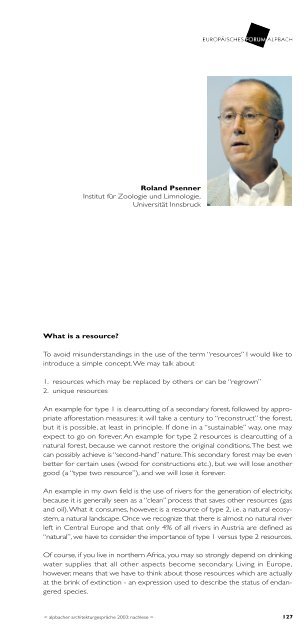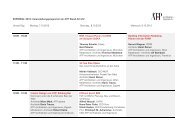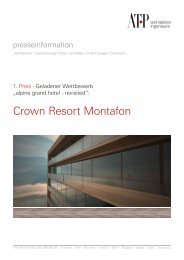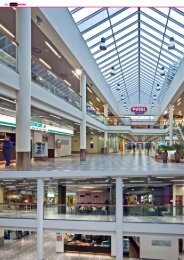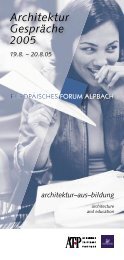alpbacher architekturgespräche 2003 - ATP
alpbacher architekturgespräche 2003 - ATP
alpbacher architekturgespräche 2003 - ATP
Sie wollen auch ein ePaper? Erhöhen Sie die Reichweite Ihrer Titel.
YUMPU macht aus Druck-PDFs automatisch weboptimierte ePaper, die Google liebt.
What is a resource?<br />
Roland Psenner<br />
Institut für Zoologie und Limnologie,<br />
Universität Innsbruck<br />
To avoid misunderstandings in the use of the term “resources” I would like to<br />
introduce a simple concept.We may talk about<br />
1. resources which may be replaced by others or can be “regrown”<br />
2. unique resources<br />
An example for type 1 is clearcutting of a secondary forest, followed by appropriate<br />
afforestation measures: it will take a century to “reconstruct” the forest,<br />
but it is possible, at least in principle. If done in a “sustainable” way, one may<br />
expect to go on forever. An example for type 2 resources is clearcutting of a<br />
natural forest, because we cannot restore the original conditions.The best we<br />
can possibly achieve is “second-hand” nature.This secondary forest may be even<br />
better for certain uses (wood for constructions etc.), but we will lose another<br />
good (a “type two resource”), and we will lose it forever.<br />
An example in my own field is the use of rivers for the generation of electricity,<br />
because it is generally seen as a “clean” process that saves other resources (gas<br />
and oil).What it consumes, however, is a resource of type 2, i.e. a natural ecosystem,<br />
a natural landscape. Once we recognize that there is almost no natural river<br />
left in Central Europe and that only 4% of all rivers in Austria are defined as<br />
“natural”, we have to consider the importance of type 1 versus type 2 resources.<br />
Of course, if you live in northern Africa, you may so strongly depend on drinking<br />
water supplies that all other aspects become secondary. Living in Europe,<br />
however, means that we have to think about those resources which are actually<br />
at the brink of extinction - an expression used to describe the status of endangered<br />
species.<br />
< <strong>alpbacher</strong> <strong>architekturgespräche</strong> <strong>2003</strong>: nachlese ><br />
127


